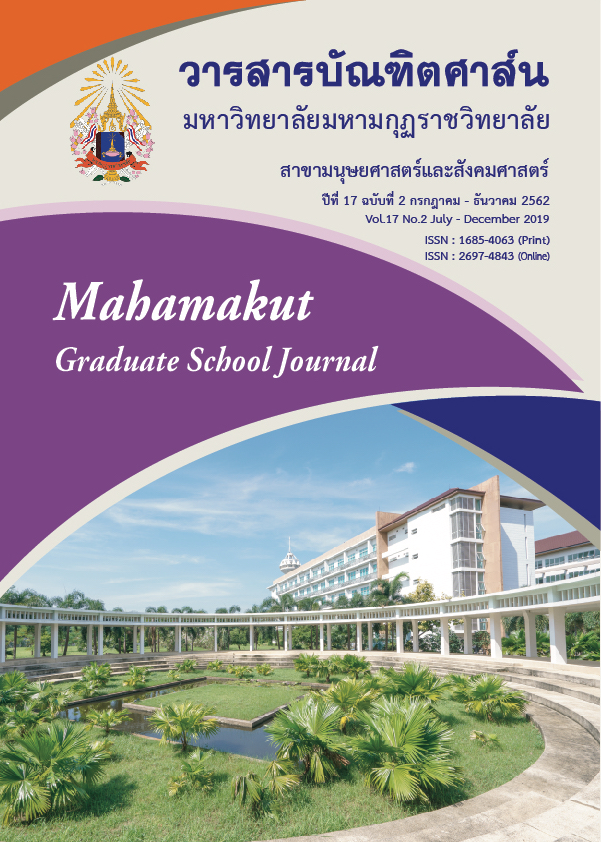การเสริมสร้างรูปแบบการเรียนรู้ด้วยกระบวนการธรรมสากัจฉาของนักศึกษา สาขาวิชาพุทธศาสน์ศึกษา บัณฑิตวิทยาลัย มหาวิทยาลัยมหามกุฏราชวิทยาลัย
คำสำคัญ:
การเสริมสร้าง/การเรียนรู้/ปรโตโฆสะกัลยาณมิตร/ธรรมสากัจฉาบทคัดย่อ
การวิจัยครั้งนี้ มีวัตถุประสงค์ ๓ ประการดังนี้ ๑) เพื่อศึกษาวิเคราะห์รูปแบบการเรียนการสอนระดับบัณฑิตศึกษา สาขาวิชาพุทธศาสน์ศึกษา บัณฑิตวิทยาลัย มหาวิทยาลัยมหามกุฏราชวิทยาลัย ๒) เพื่อศึกษาวิเคราะห์รูปแบบการเรียนรู้ปรโตโฆสะด้วยหลักกัลยาณมิตร และการเรียนรู้ด้วยกระบวนการธรรมสากัจฉา ๓) เพื่อนำเสนอรูปแบบการเรียนรู้ด้วยกระบวนการธรรมสากัจฉาของนักศึกษา สาขาวิชาพุทธศาสน์ศึกษาบัณฑิตศึกษา มหาวิทยาลัยมหามกุฏราชวิทยาลัย
ประชากรที่ศึกษาคือนักศึกษาระดับบัณฑิตศึกษาทั้งระดับปริญญาโทและปริญญาเอก อาจารย์ผู้สอน ผู้ทรงคุณวุฒิหรือผู้เชี่ยวชาญด้านองค์ความรู้ทางด้านพระไตรปิฎก โดยการเลือกกลุ่มตัวอย่างโดยไม่อาศัยความน่าจะเป็น (nonprobability) และเป็นการเลือกแบบเจาะจงจำนวน ๕๐ รูป/คน ประกอบด้วยผู้ทรงวุฒิ ผู้เชี่ยวชาญ ๕ รูป/คนคณะกรรมการบริหารหลักสูตร ๕ รูป/คนอาจารย์ผู้สอน ๑๐รูป/คนนักศึกษาปริญญาเอก ๑๕ รูป/คนนักศึกษาปริญญาโท ๑๕ รูป/คน
ผลการวิจัยพบว่า
๑.รูปแบบการเรียนการสอนระดับบัณฑิตศึกษา สาขาวิชาพุทธศาสน์ศึกษา บัณฑิตวิทยาลัย มหาวิทยาลัยมหามกุฏราชวิทยาลัยพบว่า โดยการจัดกิจกรรมให้ผู้เรียนได้ศึกษาและค้นคว้าและทำงานร่วมกัน มีการจัดกิจกรรมให้ผู้เรียนมีโอกาสแลกเปลี่ยนความคิดเห็นระหว่างผู้เรียนด้วยกันและผู้เรียนกับอาจารย์เปิดโอกาสให้ผู้เรียนได้มีส่วนร่วมแสดงความคิดเห็นในชั้นเรียน ให้ผู้เรียนสามารถคิดวิเคราะห์ ตัดสิน และแก้ปัญหาอย่างมีระบบโดยการกระตุ้นการคิด การวิเคราะห์และการแก้ปัญหา ด้วยกระบวนการกัลยาณมิตรและการเรียนรู้ด้วยกระบวนการธรรมสากัจฉา ทั้งนี้เพื่อให้นักศึกษามีความรู้ ความเข้าใจในด้านพระพุทธศาสนาและปรัชญามีวิสัยทัศน์สามารถนำหลักธรรมมาประยุกต์ให้เหมาะสมกับชีวิตในสถาพสังคมปัจจุบันผู้วิจัยจึงมีความสนใจที่จะศึกษา
๒. รูปแบบการเรียนรู้ปรโตโฆสะด้วยหลักกัลยาณมิตรและการเรียนรู้ด้วย ซึ่งถือว่าเป็นการบูรณาการเรียนรู้กระบวนการธรรมสากัจฉาเพื่อให้เกิดสัมมาทิฏฐิหรือปัญญา ดังนั้นปัญญาจะเกิดเมื่อนำปัจจัยภายนอกเป็นสิ่งที่ทำให้เกิดศรัทธาขึ้นเป็นสิ่งแรกของปัจจัยภายในและปัจจัยภายในคือโยนิโสมนสิกาเกิดขึ้นและผ่านการนำไปปฏิบัติให้มากขึ้นจะส่งให้เกิดปัญญาในที่สุด จึงสามารถสรุปลำดับกระบวนธรรมของปัจจัยภายนอกและปัจจัยภายในที่ทำให้เกิดปัญญา
๓.รูปแบบการเรียนรู้ด้วยกระบวนการธรรมสากัจฉาเมื่อพิจารณาปัจจัยภายนอกและปัจจัยภายในที่ทำให้เกิดสัมมาทิฏฐิทำให้ทราบถึงหลักการและเป้าหมาย กล่าวคือ ปัจจัยภายนอกหรือ ปรโตโฆสะ ได้แก่กัลยาณมิตร (การคบคนดี) การเสวนาธรรม และการฟังธรรม ถือเป็นปัจจัยเบื้องต้นที่มีความสำคัญต่อการศึกษาของบุคคล
ส่วนปัจจัยภายในได้แก่ศรัทธาและโยนิโสมนสิการ มีความสำคัญต่อการศึกษา เมื่อบุคคลได้รับการพัฒนาทั้งปรโตโฆสะและโยนิโสมนสิการตามหลักปัญญาวุฒิธรรมแล้วการกระทำนั้นจะสำเร็จต้องมีกัลยาณมิตรร่วมด้วยในผลสำเร็จนั้น กระบวนการธรรมสากัจฉาโดยการนำหลักสัมปชัญญะ สัปปายะ และสัมมัปปธานที่เข้ามาบูรณากับหลักปัญญาวุฒิธรรมแล้วย่อมได้ปัญญาที่เป็นสัมมาทิฏฐิในกระบวนการศึกษาแบบธรรมสากัจฉา
เอกสารอ้างอิง
: โรงพิมพ์การศาสนา, ๒๕๓๐.
คัมภีร์มิลินทปัญหาอรรถกถาภาษาไทย. พระติปิฏกจูฬาภยเถระ รจนา, ฉบับ มจร, ๒๕๕๙.
ทิศนา แขมณี และคณะ. กระบวนการเรียนรู้ : ความหมายแนวทางการพัฒนาและปัญหาข้องใจ,
กรุงเทพมหานคร : สำนักพิมพ์พัฒนาคุณภาพวิชาการ, ๒๕๔๙.
ธีรวัส บำเพ็ญบุญบารมี. โครงการธรรมศึกษาวิจัย. พุทธวิธีในการสอน : ศึกษาจากคัมภีร์พระไตรปิฎก
อรรถถา ฎีกาตลอดจนคัมภีร์ทางพระพุทศาสนา. มูลนิธีเบญจนิกาย, ๒๕๕๐.
ดุษฎี ลีตลวรางค์. “การศึกษาในสังคมพระพุทธศาสนาตามที่ปรากฏในพระไตรปิฎก”,
วิทยานิพนธ์ครุศาสตรดุษฎีบัณฑิต. คณะครุศาสตร์ : จุฬาลงกรณ์มหาวิทยาลัย, ๒๕๔๗.
ดิเรก ฤกษ์หร่าย. “การประยุกต์ใช้แนวทางพระพุทธศาสนาในการพัฒนาคุณภาพชีวิต”. วารสาร
เกษตรศาสตร์ (สังคม), ๒๕๓๐ หน้า.๑๔๓-๑๕๔.
พระมหาวิสิษฐ์ ปญฺาวฑฺฒโน (กฤษวี), การศึกษาเชิงวิเคราะห์เรื่องอุปมากถาในมิลินทปัญหา.
บัณฑิตวิทยาลัย : มหาวิทยาลัยมหาจุฬาลงกรณราชวิทยาลัย, ๒๕๔๕.
ดาวน์โหลด
เผยแพร่แล้ว
รูปแบบการอ้างอิง
ฉบับ
ประเภทบทความ
สัญญาอนุญาต
บทความวิชาการและบทความวิจัยในวารสารฉบับนี้ถือเป็นความรับผิดชอบของผู้เขียนเท่านั้น บทความที่ได้รับการตีพิมพ์ในวารสารบัณฑิตศาส์น ถือเป็นลิขสิทธิ์ของมหาวิทยาลัยมหามกุฏราชวิทยาลัย ตามพระราชบัญญัติลิขสิทธิ์



